Posts Tagged: fruit
Water Soaking of Strawberry Fruit
Found this little number the other day when picking one of my trial plots (yes, my job requires that I pick fruit; fortunately I never lack for help from my Research Assistant and the grower). The white tip of the fruit depicted in the picture below was submerged in water pooled in a dimple of the bed plastic.
Watersoaking of strawberry can take on many appearances, oftentimes a soggy and lighter colored area of the fruit. Always comes from extended contact with free water, underlining the value of keeping the plastic on top of the bed very flat and not amenable to pooling water from rain, dew and leaking lines.
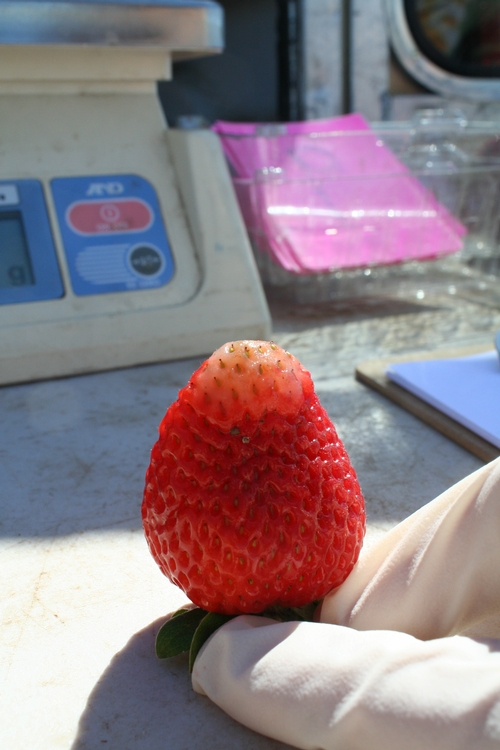
003
Rhizopus and Mucor fruit rots in strawberry.
Two pathogens that strawberry growers face all year long but especially now during the fall are Rhizopus and Mucor, which both cause a fruit rot that is distinctive and very different from the more common gray mold fruit rot caused by Botrytis cinerea.
The fruit rot symptoms caused by Rhizopus and Mucor look very similar. Fruit infected with either of these pathogens become very soft and start to leak sticky red juices from the fruit tissues. In later stages of infection fruit softens to the point that it is no longer solid and cannot be picked up without falling apart. Affected fruit are usually covered with the wispy, fuzzy black and white growth of the pathogen. Both Rhizopus and Mucor fungi are fairly easy to distinguish from Botrytis gray mold. The Botrytis fruit infection does not substantially soften the fruit, extensive leaking of fruit juices does not occur, and Botrytis growth on strawberry fruit will be gray to tan in color.
While the fruit softening symptoms of Rhizopus and Mucor are similar, the two fungi can be distinguished from one another by examining the fungal growth with a hand lens. Look for the tiny, dark brown to black, spherical structures on the ends of the white fungal strands. These black spheres are the spore bearing structures, or sporangia. For Rhizopus the sporangia appear dry while the Mucor sporangia are wet or sticky looking due to a viscous liquid film. In addition, examine the general orientation or arrangement of the sporangia within the fungal growth. For Mucor the sporangia are usually lined up in parallel rows or stands. Sporangia of Rhizopus, however, appear randomly and are not found in any particular order or arrangement.
There are several ways to minimize the infection of fruit by Mucor and Rhizopus. Use plastic mulch and drip tape, like most strawberry growers are already doing, since they minimize contact of the fruit with soil and water. Practice good field sanitation by getting rotten fruit away from plant. Handle fruit in a way to minimize wounding, which opens an avenue for these fruit rots. Cooling fruit quickly after harvest is helpful to minimize spread and development of Rhizopus, since this pathogen is not very active below 40oF; conversely Mucor is less affected by cold temperatures and could slowly develop in storage.
As for fungicides, Captan and Switch are already known to be effective. Our annual fungicide evaluation experiments include a post-harvest component and provided additional information on fungicide efficacy against Rhizopus/Mucor. Ripe fruit were harvested from each treatment replicate, placed in a dry, open air box at room temperature, and evaluated for disease for several days. We found Pristine to be consistently good at suppressing both fruit rots.
Before using any fungicide product, check with your local Agricultural Commissioner's Office and consult product labels for current status of product registration, restrictions, and use information.
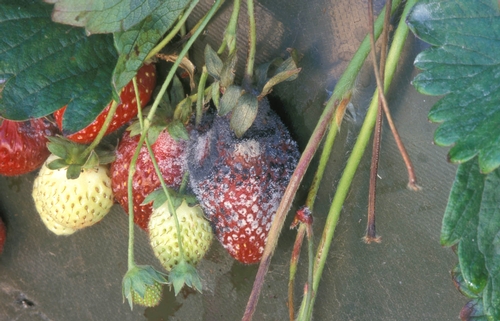
Photo courtesy Steven Koike, UCCE. Rhizopus rot on strawberry. Note the mature, black sporangia.
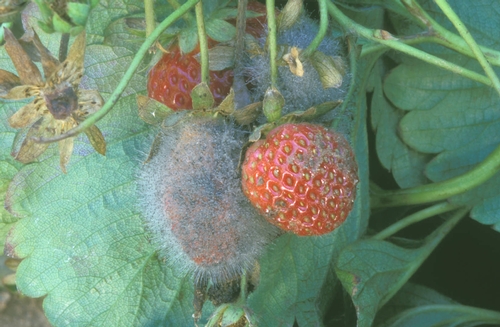
Photo courtesty Steven Koike, UCCE. Mucor rot on strawberry. Note sporangia which appear to be lined up in parallel rows or stands of this fungus.
Albino Strawberry Fruit
I had a brief chat concerning albino strawberry fruit this morning. Maybe it shouldn't be surprising that I get a call concerning this disorder since it has been rather cool and cloudy for close to a week.
Anyway, as one can see from the picture of some albino fruit off of Diamante strawberry (it's from a few years ago), the fruit takes on a pale whitish color, with just a bit of red around each achene. The lack of ripe red color comes from an inadequate supply of sugar during maturation, and indeed such fruit are insipid and tasteless.
On the Central Coast, strawberry fruit albinism tends to come in fields experiencing heavy nitrogen fertility or really frequent irrigation during an overcast period on the heels of a spell of sunny and fairly warm weather. The symptoms might be exacerbated in the shadier parts of the plant canopy, and the literature says it shows up more in closely spaced plantings.
So in order to minimize the occurrence of albino fruit, especially during a stretch of overcast conditions following warm weather, one would want to be a little more reticent about nitrogen and water use. Regardless, a change in the weather, i.e. from overcast conditions back to warm sunny weather such as we are experiencing today, is going to go miles in clearing up a spate of albino fruit.
Hat tip to the PCA for bringing this up with me. It's always great to be in touch with the experts out in the field looking at this stuff day in and day out and figuring through these problems.
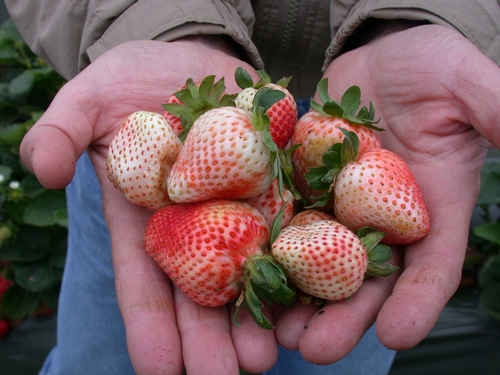
A handful of albino fruit. Note the red patches around the achenes of affected fruit.
Robotic Strawberry Harvester on the Move
For those who missed yesterday's field meeting, the following is a short summary of the presentation of a robotic harvesting machine for strawberries.
The machine, called "Agrobot", is the creation of a research group in Spain headed by Engineer Juan Bravo, who is seen driving the machine in several pictures below.
Rather than futilely attempt to match the profound and unique complexity of the human hand, the principle of the "Agrobot" is instead a construction of visualization technology which guides a rubber lined basket to the red, ripened strawberry fruit and removes it in a lifting motion from the pedicel with a small round razor buttoned to one side of the basket (photo 2 below). The picked fruit is then deposited on a conveyer belt, which carries it up to a worker seated at the front of the "Agrobot" for quality inspection and placement in a container, be it a clamshell, crate or bucket.
There are a series of arms holding the harvest baskets on either side of the machine to enable picking on both sides of the bed. Much has been of the fact that these arms, having a modular design, are replaceable in case of damage or malfunction. The unit containing the arm and its automated guide snaps easily out to make room for an identical unit, causing minimal delay in the progress of harvest.
Nice video by Luis Macario posted on youtube:
http://www.youtube.com/watch?v=nm3WS5y3kCk&feature=youtu.be
While the "Agrobot" automated harvester is being seen as technology's response to the strawberry industry's increasing problems obtaining harvest labor, many challenges remain nevertheless. For one, the varieties currently in use on the Central Coast produce many fruit in one cluster, which the machine has difficulty distinguishing from one another. Secondly, as the reader can see from picture number three below, the strawberry field must be radically reshaped to accommodate the machine, including farming strawberries in single rows (reducing plant count and subsequently lowering yield per acre) and raising the beds substantially. Third, the machine cannot think for itself and will not find fruit behind foliage or sequestered within the canopy of the plant.
At any rate, the "Agrobot" is a remarkable invention and worthy of a look and consideration by those who haven't seen it yet.
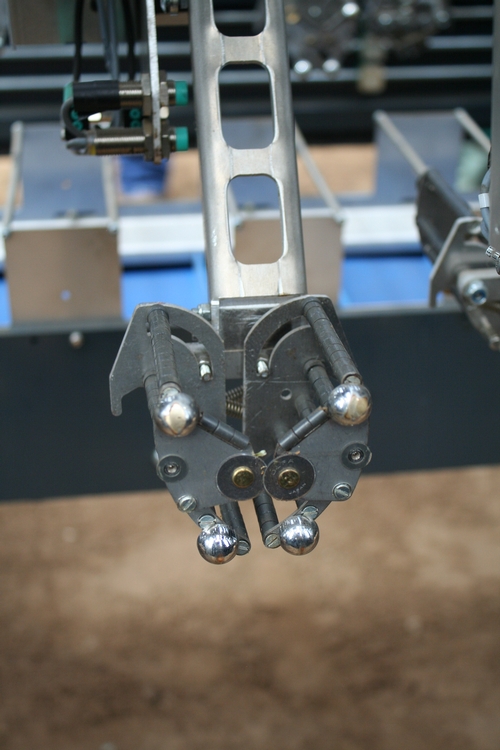
Fruit picking basket, optics are in the back.
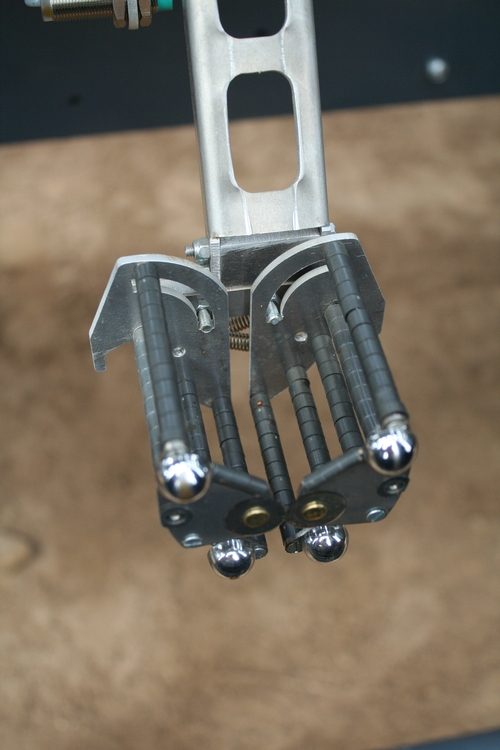
Close up of fruit picking basket, thin round plates are razors which remove fruit from the pedicel. Note that blade can be rotated when it becomes dull on one side to expose sharper cutting edge.

"Agrobot" robotic harvester preparing to enter strawberry field. Note significant height of strawberry beds and single row planting. Variety is 'Albion', common to the Central Coast of California.
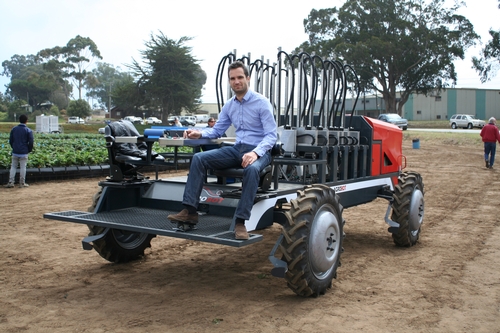
Ingeniero Juan Bravo manuvers the Agrobot out of the field.
Effect of Strawberry Transplant Crown Size on Plant Growth and Fruit Yield
Introduction: As the planting season for strawberry approaches, it is useful to review some concepts of strawberry plants and planting. Strawberry growers occasionally have questions about the size of strawberry transplants (i.e. crown size) and its effect on plant growth and yield.
The following is a summary of a study run over two years as an investigation of whether strawberry crown size had any effect on strawberry fruit yield and size.
For those who want to see the full report, it starts on page 5 of the Monterey Crop Notes for November/ December 2007.
http://ucanr.org/cropnotestransplant2007
Materials and Methods:
Treatments: The trials were conducted in a well managed organic farm in Moss Landing, CA. In year one, the study consisted of treatments of “large” and “small” size transplants. Measurements were done with a caliper at the middle of the crown. The following varieties were tested at the sizes given below:
Seascape: small < 1.1 cm, large > 1.2 cm
Transplants were dug 10/27/04 in Macdoel, and planted 11/16/04.
Aromas: small < 1.1 cm, large > 1.3 cm
Transplants were dug 10/26/04 in Macdoel, and planted 11/9/04.
In year two, the study included a third treatment, consisting of “slicks” (known as “lisas” in Spanish) for the varieties of Seascape and Albion. “Slicks” are very small crowns which are almost entirely made up of primary roots and no secondary roots, giving them a smooth appearance (see photo accompanying this article).
Seascape: “slicks”, < 1.1 cm, large > 1.2 cm
Albion: “slicks”, small < 0.9 cm, large > 1.1 cm
Both Seascape and Albion transplants were harvested in MacDoel 10/25/05, and planted 11/22/05
It should be noted that the large crowns in each treatment were not a common feature. In each box of 1000 crowns large crowns represented probably 5-10% of the total numbers of plants.
Plants were measured for plant diameter early in the season, possibly on a monthly basis. Fruit yield, both count and weight of fruit from each replicate plot, were evaluated by harvest by qualified personnel harvesting on a regular schedule.
Results: In the first year trial, plants of treatments planted to small crown sizes had smaller diameters than larger crowns one and a half months after transplant. Three months after transplant this difference had disappeared. There were no significant differences in plant diameters at any date in any size categories for the varieties tested in year 2.
Fruit production was significantly lower in smaller crowns of Aromas in the summer months of year 1, and resulted in lower total fruit production. There were no differences in fruit production in year 1 or year 2 for Seascape.
For Albion, fruit production for "slicks" and small crowns was significantly lower than large crowns in the months of June and July, but there were no differences in total yield between any size class.
With very little exception did fruit size vary significantly between any of the crown size treatments by month or through the season.
Discussion: Although there was some variation by month for certain varieties, transplant crown size was not a good predictor of total strawberry fruit productivity in this study. What this means is that, while there was some cyclicality in production for some varieties, size of the strawberry transplant did not have an effect on total fruit yield.

"Large" is on the left, "small" size class is on the right

"Slick" or "lisa" is on the left, "small" is on the right

"Slicks" are on the left, "small" in the middle, "large" on the right

